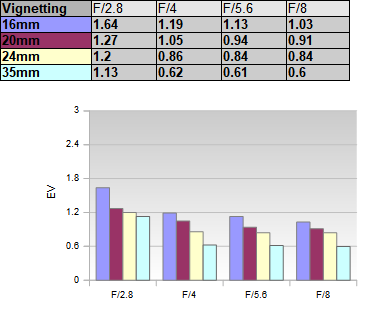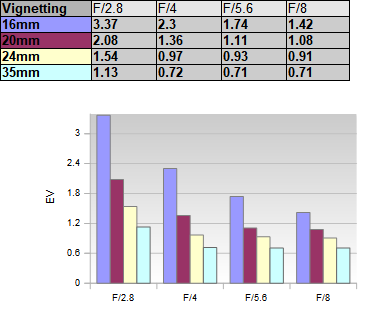|
Sony FE 16-35mm f/2.8 GM ( SEL1635GM ) - Review / Test Report - Analysis |
|
Lens Reviews -
Sony Alpha (Full Format)
|
|
Page 2 of 3

Distortion
If you rely on Sony's image auto-correction algorithms, there's little to worry about in terms of distortions. A maximum of 0.6% barrel distortion at 16mm may be just noticeable but it's far from disturbing.
The native characteristic of the lens is, of course, worse albeit not excessive for a lens in this class. At 16mm there is a heavy barrel distortion of ~4.2%. This is reduced to a moderate degree at 20mm and the Sony lens is pretty much free of distortions at 24mm. From there, the distortion characteristic switches to pincushion type reaching a moderate 1.3% at 35mm.
Vignetting
A similar story line applies to vignetting. With activated vignetting correction, there's still a visible light falloff of 1-1.5EV (f-stops) at fully open aperture. Stopping down reduces the issue a bit but trace of vignetting remain albeit below disturbing levels.
 When looking at the native characteristic again, the vignetting is very pronounced with a peak of ~3.3EV (f-stops) at the wide-end at f/2.8. That being said the Sony FE 16-35mm f/2.8 GM remains in line with DSLR lenses in this class here. You can still spot a substantial light falloff at 16mm f/4 and 20mm f/2.8. As you might expect, it's a lesser issue at longer focal lengths. The vignetting doesn't disappear at 16mm even at f/8 but it's not all that obvious anymore.
When looking at the native characteristic again, the vignetting is very pronounced with a peak of ~3.3EV (f-stops) at the wide-end at f/2.8. That being said the Sony FE 16-35mm f/2.8 GM remains in line with DSLR lenses in this class here. You can still spot a substantial light falloff at 16mm f/4 and 20mm f/2.8. As you might expect, it's a lesser issue at longer focal lengths. The vignetting doesn't disappear at 16mm even at f/8 but it's not all that obvious anymore.

MTF (resolution)
The Sony FE 16-35mm f/2.8 GM does a good job here but it's not without issues. The lens has been optimized towards the wide end of the range. The center quality is generally superb throughout the range - even with a high megapixel camera ( we are testing at 42mp ). At 16mm and 20mm the "near center zone" remains great. At 16mm f/2.8 the outer image field is fairly soft but improves when stopping down. The peak quality is reached around f/5.6 with good to very good borders/corners at 16/20mm. There's a drop in quality from 24mm onwards. The borders/corners are soft again at f/2.8 but recover to good levels from f/4. For the best quality stick to f/5.6 or f/8 here. Diffraction is limiting the quality at f/11.
The amount of field curvature is surprisingly low. The centering quality of the tested sample was good.
Please note that the MTF results are not directly comparable across the different systems!
Below is a simplified summary of the formal findings. The chart shows line widths per picture height (LW/PH) which can be taken as a measure for sharpness.
If you want to know more about the MTF50 figures you may check out the corresponding Imatest Explanations
Chromatic Aberrations (CAs)
The amount of lateral chromatic aberrations (color shadows at the image borders) is very low considering the high megapixel sensor. The CAs peak at 16mm with an average pixel width around 1.2px at the image borders (somewhat more in the corners). However, that's more than acceptable already and it's even less at longer focal lengths.

|